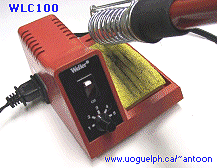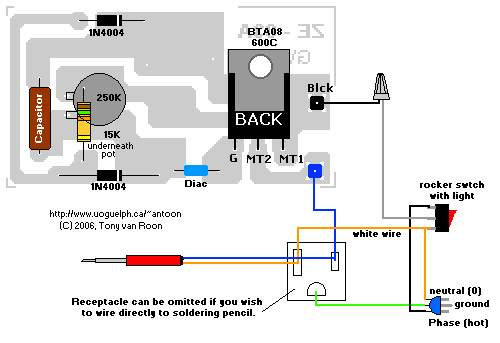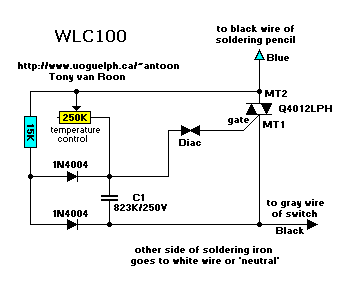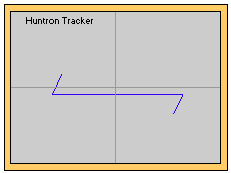 Weller WLC100 Electronic Soldering Station
Weller WLC100 Electronic Soldering Station
One day you switch on your soldering station (in my case a Weller WLC100). You flick the switch and the red light
comes "ON", indication power is okay. Ten minutes later you get ready to solder and find the soldering pencil is not
hot at all. What the...?! After the usual frustration period of confusion and bad words you decide to investigate
and fix the problem. After all, you are a techie or technical inclined and you can 'fix anything'. Right?
Well, read on. I was in a similar situation and in for a 'quick-fix'; NOT! I started to take the one visible screw
out from the bottom cover plate. The other two screws are hidden underneath the rubber feet at the left.
As mentioned before, the circuit board is small.
I pulled the knob off and unscrewed the nut holding the switch to the body. I marked the wiring on a piece of paper
and took the pcb out all the way. We had brown outs and power-failures that afternoon so my first thought was a
defective diac but after a quick test with the Huntron Tracker it proved to be good (see diagram below).
Okay, on to the Triac. The triac tester showed the triac capable of switching and holding its state. Also good.
Finally it occurred to me to check the heater coil (HE40) in the soldering pencil itself. Yep. Darn thing was open.
Murphy's Law at work again. Could have saved myself a lot of time by thinking first instead of taking the station
apart impulsively. Oh well, one lesson learned.
This station lasted about 6-years of 7-hour a-day use, so really fantastic. Power output is adjustable from 5 to 40
Watts via a potentiometer on the front panel. This station is supplied with a ST3 1/8" screwdriver tip. Seems to be
suitable for almost all jobs, minus some fine-soldering jobs on surface mount boards. I was unable to order
replacement parts (heater) for my older model I was forced to purchase a new station, not really expensive though,
they are around $55.00 Canadian in my area so a good buy.
The WLC100 is a cheap and well build, temperature controlled, soldering station and works really well for most
applications. Some vendors will sell this station as a WTC100 'stained glass' model. Same thing and same price. Don't
let them fool you! Below I have drawn out the lay-out and pcb, and included a circuit diagram and parts list. The
pcb measures about 1-7/8 by 1-inch. This document my help you in repairing your own station if the time comes.


Parts List:
R1 = 15 Kilo-Ohm, brown-green-orange, 1/8 Watt, 5%
P1 = 250K potentiometer
C1 = 823K, 250V
D1,D2 = 1N4004
D3 = Diac, bilateral trigger type
Q1 = Triac 400V/25A,*Q4012LPH (Teccor), or BTA08600c (Philips), or other

*CAUTION: The Triac has an Isolated tab, so if you need to substitute make
sure to use the same type. Two replacements for the Q4012LPH are the Q4015L5 or the NTE56020. Another station I
opened up had a BTA08600C Triac (ST) from Philips in it.
 Notes:
Notes:
The Diac I tested with an instrument called a "Huntron Tracker". It showed okay. Look at the picture at the left
what a 'good' signature is for a diac.
Newer soldering stations of the same model and type now have a receptacle at the left side, soldering iron plugs into
here. Much easier to service this way, and also to check the condition of the triac by plugging in a regular 40W
lightbulb. If the brightness varies, the triac is okay, if not it is defect.
Please Note: the TRIAC is mounted then bend over forward!
Overall, in my opinion it is a nice, cheap way to get most of the jobs done. If you are afraid of ESD, just mount a
piece of wire and a 1 Mega-ohm resistor between the metal part of the soldering pencil and ground.
Below are some good points made by Greg:
1. The standard iron with this station does NOT have a grounded tip.
While this is acceptable for the hobby and stained glass industry usage, I
do NOT recommend the standard iron with this station for electronic work with
discrete components (transistors, IC's, CMOS, MosFets, etc.) where a grounded
tip is preferred. (Electro Static Discharge or ESD).
2. The Weller WPC300 station (a base unit sold without an iron) appears to be
the WLC100 without including the iron. Neither the WLC100 or the WPC300 are
ESD safe. [Irons]
3. The WLC100 base unit whould be able to support other Weller irons (less than
300 watts) with the convenient 115/220 VAC outlet on the left side of the
base. The Weller WP25, WP30, and WP35 irons (use same "ST" tips) as well as
the WM120 Mini Soldering iron (12W) which uses MP tips, ALL grounded tips.
4. Replacement heater element for the WLC100 is the HE40 type. Both parts are
available from: [WLC100] if you need it.
5. The WLC100 lighted rocker (Power) switch (Carling 12A; 125VAC w/125VAC lamp -
Weller part #EC219) is the same as used in the WTCPT (PU120T) and early
version - series 1) base units.
6. Also, there is added weight inside the base of these units to make sure they
don't flip over backwards when the soldering pencil is in the holder. This
added weight can be either a simple iron plate in the older units, or a
rectangular sealed Teflon bag filled with lead beads in the newer models.
Don't loose this weight bag, or your station becomes unstable.
7. Some owners reported that the set-screw used to secure the tip 'catching' the
funnel rim of the iron spring. "Pace" soldering irons use a flush mounting
8-32 screw to hold their 1/8" and 3/16" shank iron tips.
(Tony: the first to do is replacing the old screw with a steel hex one)
8. (Tony) The WLC100 station is NOT fused in any way. Add your own fuse if you
wish, but personally I find it not necessary. Hence Weller is thinking same.
9. A few recommendations if you purchase this unit:
- Purchase the ST1 tip (1/16" screwdriver profile). Excellent for PCB work.
- The ST3 tip that comes with the station is more suitable for point-to-point
wiring like switches, connectors, "boat anchors", etc.
- For novices I do NOT recommend the conical or "pointy" profile soldering
tip. Once you have a good soldering technique, use this tip as you become
more proficient.
- This model is currently listed on Weller® 2005 Spring Promotion at a
price of $29.99 USD. [Cooper Tools]
WLC100/WTC100/WP25-3, and WP35-3 Replacement Parts:
WCC104 - Replacement tip cleaning sponge
HE40 - Heater element
WCC105 - Iron spring (soldering pensil holder)
WPB1 - Weller® Polishing Bar
ST1 - Weller® Screwdriver Tip 1/16"
ST2 - Weller® Screwdriver Tip 3/32"
ST3 - Weller® Screwdriver Tip 1/8" (3.17mm) (standard)
ST4 - Weller® Screwdriver Tip 3/16"
ST5 - Weller® Flat Tip 1/32"
ST6 - Weller® Screwdriver Tip 1/32"
EC219 - Lighted rocker (on/off) switch
Spare parts for Weller in Europe can be found here:
Spare Parts
Weller, Weller®, WLC100, WTC100, WP25-3, WP35-3, PCB, and Schematic, are
copyright, owned, and trademarked by Weller Corporation.
Thanks to Greg Beat (W9GB) for his input to make this article complete! Thanks Greg. -Tony
Back to Circuits Page
Copyright © 2002 - Tony van Roon.
Last updated on November 29, 2007.





 Notes:
Notes: